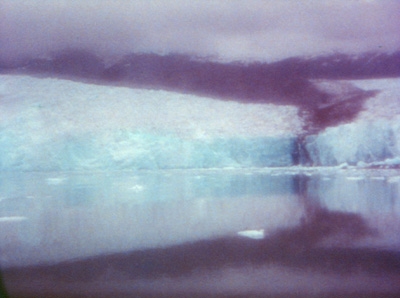

1979, 16 mm, colour, silent, 16 min.
"In Creation (1979) [Brakhage] recorded a visit to Alaskan glaciers... The proximate inspiration for the sublime vision of a world of massive ice and scarred rock was the art of the nineteenth-century American landscape painter, Frederic Edwin Church, whose works Brakhage had studied for more than a decade. Behind Church's paintings of icebergs lay a rich pictorial and literary tradition highlighted by Caspar David Friedrich's Arctic scenes and the Antarctic fantasy of Poe, in his conclusion to The Narrative of Arthur Gordon Pym... the phrasing of imagery in Creation mimics a skewed version of the opening chapter of Genesis, from which he derives his title. Sweeping over a surface of dramatic lights and darks like the divine wind, the camera shortly discovers water. A few minutes later in a brilliant and dramatic coup, Brakhage suggests the division of the waters into upper and lower, heaven and earth, by flipping the filmstrip over, so that icebergs seems to hang down from a fluid sky. Thus by boldly reversing top and bottom, as well as forward and back motion, Brakhage presents the gorgeous illusions of icebergs flowing backwards in the sky as indeed illusionary... The organization of material in Creation unmistakably follows the basic Biblical scenario, although even before the division of the waters, Brakhage introduces images of vegetation, as masses of fog rise from pine covered mountains. The rhythmic intercutting of forward and flipped movement through the glaciers incorporates shifts of lighting suggestive of day and night... in Creation, Brakhage pretends to be so utterly alone in the Alaskan bay that his persona imperceptibly emerges from an embodiment of the divine wind itself."
P. Adams Sitney
Chicago Review, Spring 2002
